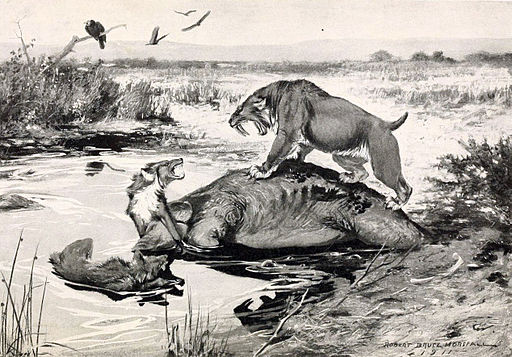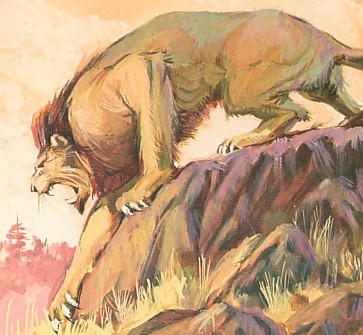Interactions with Other Species
Smilodon fatalis Interaction with Prey
Smilodon fatalis was a well known hunter in aspects of
ambush and capture. Most of their prey fell to a swift death when
their necks met the sharp edge of the saber-tooth cat's upper
canines. How did they subdue their prey so fast and
efficiently? While this method is not highly encouraged in today's
society, the hunt begins with stalking the prey.
The stalked prey would normally be isolated but there are cases where Smilodon fatalis would subdue the weakest of the group (Turner 1997). After stalking the prey for some time, the saber-tooth cat would go in for the kill by pouncing on the prey. With the help of their large forelimbs and retractable claws, the saber-tooth cat would wrestle the prey to the ground (Turner 1997). They would finish the prey off with a bite to the neck; severing the windpipe and securing the kill (Turner 1997). Larger animals are subdued by applying bites to areas that cause major internal bleeding to slowly weaken the prey (Turner 1997).
The carcass was often consumed using a lateral bite to avoid bone contact with the upper canines (Turner 1997). The prized meat was often shared with fellow Smilodon fatalis or fought over with Canis dirus. S. fatalis were thought to have scavenged as well when they were not hunting. A popular hypothesis used to explain their scavenging behavior was the distress calls of a prey (Carbone et al. 2009). The result would be an easy meal but they would unfortunately share the same fate as their prey, to be trapped (Turner 1997). Whether the Smilodons hunted or scavenged for food, their robust physique was a force not to be reckoned with.
Interaction with Canis dirus
 Smilodon fatalis was one of the more dominant carnivore of the
Pleistocene epoch during fierce competition for food with other
species. Canis dirus, the dire wolf, was an equally
preserved species of the Canidae during the time of S. fatalis
(Coltrain et al. 2004).
C. dirus was able to compete closely with S. fatalis
despite their smaller size. During a S. fatalis hunt, the
distress calls of the prey usually draws the attention of other
S. fatalis as well as C. dirus (Coltrain et al. 2004). The saber-tooth cat
would usually leave the carcass for others to attend to after their
meal (Coltrain et al. 2004). Scientists
have theorized that S. fatalis may have left carcasses to
promote a coevolutionary relationship with the dire wolf (Coltrain
et al. 2004).
Smilodon fatalis was one of the more dominant carnivore of the
Pleistocene epoch during fierce competition for food with other
species. Canis dirus, the dire wolf, was an equally
preserved species of the Canidae during the time of S. fatalis
(Coltrain et al. 2004).
C. dirus was able to compete closely with S. fatalis
despite their smaller size. During a S. fatalis hunt, the
distress calls of the prey usually draws the attention of other
S. fatalis as well as C. dirus (Coltrain et al. 2004). The saber-tooth cat
would usually leave the carcass for others to attend to after their
meal (Coltrain et al. 2004). Scientists
have theorized that S. fatalis may have left carcasses to
promote a coevolutionary relationship with the dire wolf (Coltrain
et al. 2004).
Interaction with Panthera atrox
Panthera
atrox, the American lion, was found to be a strong rival
competitor with Smilodon fatalis (DeSantis et al. 2012). They both equally hunted
on the same turf, each hunting to their own liking. P. atrox
was known to have hunted far bigger animals than S. fatalis
due to their immense size (DeSantis et al. 2012). The fossil records show that P. atrox
had a higher incidence of tooth breakage compared to S. fatalis
(DeSantis et al., 2012).
 This shows that the American lion applied more stress onto their
mandibles which makes sense if they were hunting bigger game. The
saber-tooth cat had high incidences of canine breakages but was
still lower than the American lion (DeSantis et al. 2012). This also suggests that S.
fatalis indeed hunted smaller game or that they had fewer
captures compared to P. atrox (DeSantis et al. 2012).
This shows that the American lion applied more stress onto their
mandibles which makes sense if they were hunting bigger game. The
saber-tooth cat had high incidences of canine breakages but was
still lower than the American lion (DeSantis et al. 2012). This also suggests that S.
fatalis indeed hunted smaller game or that they had fewer
captures compared to P. atrox (DeSantis et al. 2012).
Scientists hypothesize that the saber-tooth cat hunted half the time and then resorted to scavenging the leftover carcasses from other successful captures (DeSantis et al. 2012). The isotope signatures found in the preserved bones of Smilodon fatalis in Rancho La Brea supports this statement. The saber-tooth cat was found to have lower carcass consumption, meaning they did not eat all the way to the bone (DeSantis et al. 2012). This is in comparison to Panthera atrox since they had higher tooth breakage, they probably utilized the carcasses to a fuller extent (DeSantis et al. 2012). Although they were competing for a common food source, there are not much evidence on the frequency in which they came in contact with one another.
To continue on the journey, visit
Facts next!
To return to the Smilodon fatalis homepage, click
here.
